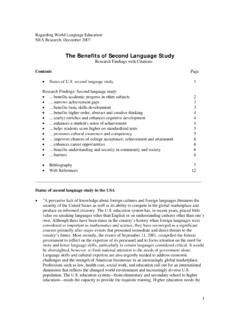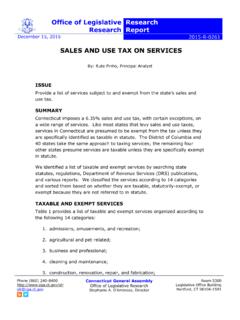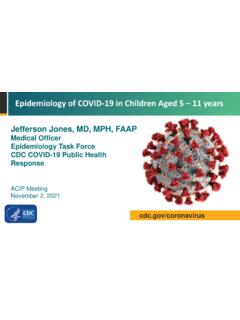Transcription of Student-Centered Learning in Higher Education
1 International Journal of Teaching and Learning in Higher Education 2011, Volume 23, Number 3, 92-97 ISSN 1812-9129 Student-Centered Learning in Higher Education Gloria Brown Wright Central connecticut State University In her book, Learner- centered Teaching, Maryellen Weimer contrasts the practices of teacher- centered college teaching and Student-Centered college teaching in terms of (1) the balance of power in the classroom, (2) the function of the course content, (3) the role of the teacher versus the role of the student, (4) the responsibility of Learning , (5) the purpose and processes of evaluation. She then gives some suggestions on how to implement the learner- centered approach. Using Weimer s five specifications, it has been possible to identify from the pedagogical literature several examples where college teachers are seeking to move toward more Student-Centered classrooms.
2 This essay reports on innovations used by teachers across the academic and professional spectrum, as well as on their evaluations of their successes. This essay presents some classroom innovations carried out by various college instructors using the context of Maryellen Weimer s Learner- centered Teaching (2002.) The objective of Weimer s book was to show how the principles discussed in Stephen Brookfield s Becoming a Critically Reflective Teacher (1995) can be applied in actual classroom settings. Weimer s working thesis is that classrooms at the college/university level are extremely instructor- centered and that this situation works against students becoming successful, mature learners.
3 She says that many instructors recognize this and try to make changes in the direction of more student-centeredness, even though their level of awareness of the problem varies from those who know what the specific problem areas are to those who simply have a sense that all is not right in the educational process. Weimer identifies five areas where the teacher-centeredness of the classroom is clearly seen: the balance of power, the function of content, the role of the teacher, the responsibility of Learning , and the purpose and processes of evaluation. For each area she outlines the evidence and describes examples of alternative approaches for creating Student-Centered classrooms.
4 Although in the literature or in usage the concept is not always clearly used with consistent meaning (Paris and Combs, 2006), the common concern is to adjust teaching activities in ways that can enhance student Learning . There is growing interest in Student-Centered Learning in Higher Education , and many universities provide on-line resources for their professors at their websites. Weimer s thesis that moving toward learner- centered teaching will lead to greater success for students and increased job satisfaction for teachers is supported in the pedagogical literature: there is recognition that the affective and cognitive domains interact to determine classroom effectiveness.
5 That several college teachers are moving in the direction of learner- centered teaching is evidenced from the examples described in this essay. The Balance of Power Weimer (2002) makes the observation, supported by experiences from her own classes, that for the most part decisions about the course are made by the instructor and that this is exactly what students want and expect. She uses the course outline as an example, asking rhetorical questions about who determines the content, the schedule, the conditions for Learning , the attendance policies, and the evaluation process. She states that the very language used to communicate this information is in the form of heavy-handed directives which make clear that the teacher is in charge.
6 She describes the students in today s colleges and universities as anxious and tentative rather than empowered, confident and self-motivated, and she recommends that professors begin sharing power with students from the start by, for example, providing them with a list of assignments from which they choose a specified number that they will do. Tyma s (2009) experience teaching a media literacy class aptly illustrates the shifting of the decision-making in a class to empower the students . On the first day of classes when he posed the question of what they wanted out of the course he was met with stares from the five incredulous students .
7 He was determined that they would be actively involved in the creation of the course, even as he carried out his responsibilities to the university as course manager and evaluator of student achievement. Their first assignment was to return the next class prepared to share ideas on how the class would proceed. At the following class meeting he presented three options, and after discussion one was voted for adoption. One student dropped the course before the next class, and still another before the second week of the semester, and so the three remaining students set about designing the course. The ideas did originate with the instructor, and it was he who identified an external resource person, but by inviting their input he involved them in deciding how the course would be conducted: projects Wright Student-Centered Learning 93 which would encapsulate the course content and fulfill the course objectives, the format and timetable for course activities, an electronic delivery medium for sharing work and communicating with each other, and the assessment activities and evaluation criteria.
8 It was decided that the students roles would be primary as project experts while Tyma s would be the advisor for the project, even as he retained ultimate responsibility for monitoring the students and guiding them toward success in meeting the objectives of the course. Thus, while shifting a great deal of power over to the students , Tyma reserved enough to guarantee the integrity of the course. Maintaining a subordinate role in which he functioned as catalyst, advisor, or facilitator and letting the students be in charge was a challenge to Tyma, a novice college instructor, especially as the students sometimes seemed anxious to cede their power to him and let him make decisions.
9 This is also a challenge to many experienced educators who, according to Estes (2004) and Liu et al. (2006), although claiming to value Student-Centered Learning , were inconsistent in their practices. As Tyma s students carried out their assigned roles many desirable outcomes, which would not have been achieved with the teacher maintaining the traditional position of power, were achieved: each student gained experience functioning both as liaison and as leader; the class took the initiative in suggesting adjustments when it was felt necessary; and they successfully completed a project which benefited a community group. The Function of Content The need to cover the content of the course has led, according to Weimer, to a neglect of ensuring that the course objectives are being met.
10 It has also led to erroneously equating a good course with a rigorous course, rather than a course in which students learn. In consequence, when faced with an unmanageable amount of course content, students resort to memorization rather than conceptualization, using a binge and purge approach to examinations. In such an environment the successful student is the one who has mastered the ability to reproduce information required by the teacher, too often at the lower levels of knowledge. Weimer (2002) appeals to college instructors to use course content, not just as an end in itself, but as a means of helping students learn how to learn.













